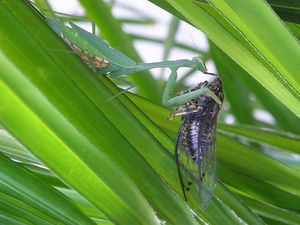Biological pest control: Difference between revisions
No edit summary |
mNo edit summary |
||
| Line 1: | Line 1: | ||
{{Category=Pests and weeds}} | {{Category=Pests and weeds}} | ||
[[File:Mantis.jpg|center|300px]] | [[File:Mantis.jpg|center|300px]] | ||
Biological pest control (also called Integrated Pest Management) is using useful organisms to deal pest organisms. If you have grasshoppers destroying your vegetables, see it as an opportunity! Those grasshoppers represent energy and biological matter in your garden and all you have to do is convert that into a more desirable form. You can do this by getting turkeys; a turkey can transform 3kg of grasshopper into 1kg of valuable meat. | Biological pest control (also called Integrated Pest Management) is using useful organisms to deal with pest organisms. If you have grasshoppers destroying your vegetables, see it as an opportunity! Those grasshoppers represent energy and biological matter in your garden and all you have to do is convert that into a more desirable form. You can do this by getting turkeys; a turkey can transform 3kg of grasshopper into 1kg of valuable meat. | ||
The following are some useful online tools for planning biological pest control: | The following are some useful online tools for planning biological pest control: | ||
Revision as of 22:53, 5 March 2011
Main > Food and Agriculture > Pests and weeds
Biological pest control (also called Integrated Pest Management) is using useful organisms to deal with pest organisms. If you have grasshoppers destroying your vegetables, see it as an opportunity! Those grasshoppers represent energy and biological matter in your garden and all you have to do is convert that into a more desirable form. You can do this by getting turkeys; a turkey can transform 3kg of grasshopper into 1kg of valuable meat.
The following are some useful online tools for planning biological pest control:
http://attra.ncat.org/attra-pub/biorationals/ - A tool where you select your pest and it gives a list of predators. Focused on North America.
http://www.cdpr.ca.gov/docs/pestmgt/ipminov/bensuppl.htm - Lists suppliers of beneficial organisms in North America
APHIS National Biological Control Institute (NBCI) - USDA Animal and Plant Health Service - http://www.aphis.usda.gov/nbci/nbci.html
APHIS Plant Protection Centers - USDA Animal and Plant Health Service - http://www.aphis.usda.gov/PPQ/bco/
Auburn’s Biological Control Institute (BCI) - Auburn University - http://www.ag.auburn.edu/bci/bci.html
Cornell’s Biological Control Home Page - Cornell University - http://www.nysaes.cornell.edu:80/ent/biocontrol/index.html
Florida Agricultural Information Retrieval System - University of Florida - http://hammock.ifas.ufl.edu/
Florida’s National IPM Network - University of Florida - http://hammock.ifas.ufl.edu/tmp/en.html
NEB Guide - Biological Control of Insect and Mite Pests - University of Nebraska Cooperative Ext. - http://ianrwww.unl.edu/ianr/pubs/extnpubs/insects/g1251.HTM#SOURCES
North Carolina’s National IPM Network (North Carolina State University) - http://ipmwww.ncsu.edu/
North Carolina State BioControl Contents - North Carolina State University - http://ipmwww.ncsu.edu/biocontrol/biocontrol.html
Purdue’s Biological Control Laboratory - University of Purdue Cooperative Extension - http://www.entm.purdue.edu/entomology/bclab/biocontrol.html
University of California IPM Home Page - University of California at Davis - http://www.ipm.ucdavis.edu/
